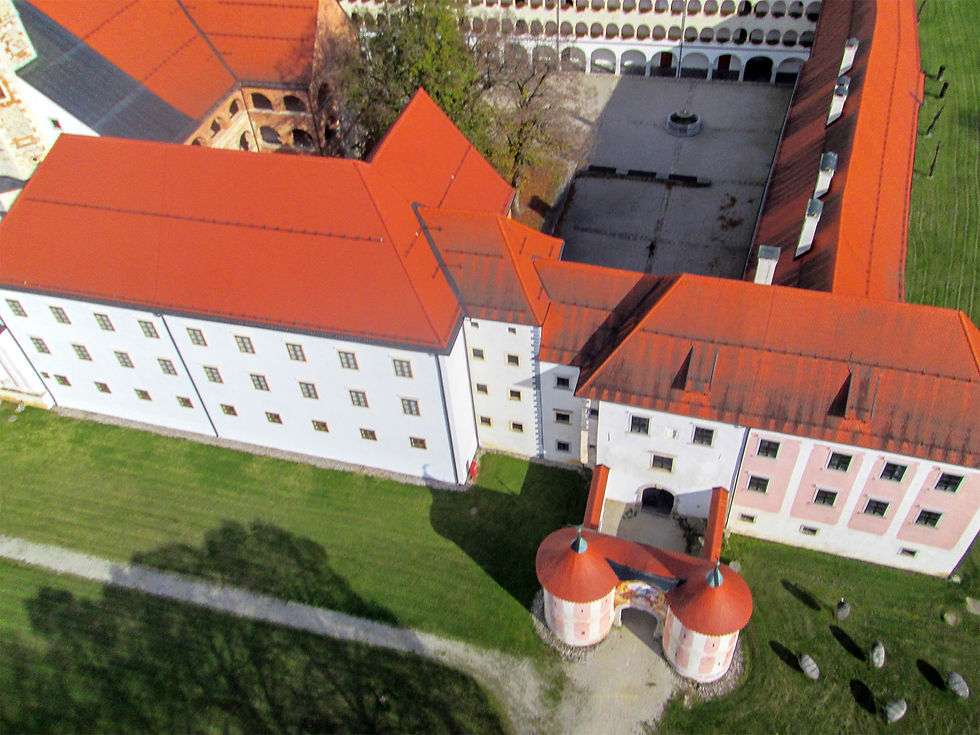Ancient Monastery and Contemporary Art
- kapjasa
- Nov 2, 2018
- 3 min read
Let's unfold the kite and fly - 800 years into the past! ... In 1234 the Duke of Carinthia Bernhard Von Spanheim consolidated his posessions in Lower Carniola by establishing a Cistercian monastery at a spring called Obrh, not far from the town of Kostanjevica on the river Krka. The monastery complex, now an exibition place and art gallery, is one of the largest and best preserved examples of sacral architecture in Slovenia - and beyond.

Oldest extant building at the Kostanjevica na Krki Cistercian monastery, the Romanic-Gothic St. Mary of the Annunciation church. The nave is from 1234, the bell tower was added in 15th century.
The monastery was called Fons Sanctae Mariae, The spring of St. Mary. Bernhard bestowed ample estates on the monastery, so it became one of the richest landowners in Carniola. The monastery was an important a centre of religious, educational, mercantile and commercial life - at its peak, the monastery was home to 86 monks and lay brothers.

The Baroque arcade courtyard of the monastery; the largest in Central Europe.
The original Early Gothic monastery was renovated and completed during the Renaissance and Baroque. In the 18th century the Baroque coulisse and two small defence towers with painted decoration by renowned Slovene artist Fran Jelovšek were built, and one of the largest arcade courtyards in Europe was completed - 75 meters long and 50 metres wide, with 234 arches in three storeys.

Front façade of the monastery. The small defence towers sporting embrasures (loopholes and arrowslits) guard the entrance.
But as the magnificent monastery was completed and a true golden era was just around the corner, the Habsburg court in Vienna had some ideas about Enlightenment, curbing the power of the Church - and getting more money. In 1786 Emperor Joseph II dissolved almost all the monasteries in Austrian Empire, and the monastery at Kostanjevica na Krki was no exception. Its property was transferred to the Carniolan religious fund (under Imperial control), and the church of St. Mary was deconsecrated. The monks moved out, replaced by the forestry administration and notary services.

The15th century belltower of the Gothic church, and the 18th century coulisse, painted by Fran Jelovšek.
This did not bode well for the former monastery. The process of decay was slow yet inevitable, culminating in the almost complete destruction during the Second World War. Only after the war the exceptional architecture of the complex was recognized and efforts were started to reconstruct and preserve it. Thorough restoration begun in 1957 and is still in progress. In 1989 the monastery was declared a cultural monument, protected by the state.

Obrh stream - the eponymous Fons Sanctae Mariae -, meadows and fields behind the monastery.
During the renovation the Contemporary Art entered the monastery. In 1974 the Božidar Jakac Art Museum was established here, with several galleries and exhibition places. The exhibitions and concerts taking place in the former church are especially recommended - its Gothic, skyward, and incredibly acoustic architecture gives a truly sublime experience.
More then 100 sculptures are on display in and around the monastery. They were created on sculptural symposiums Forma Viva by artists from all over the world, starting in 1961 and held biannually from 1988. Sculptures are made from oak wood, typical for this part of Slovenia.

Outer courtyard with Forma viva wooden artworks and scuptures, and the Baroque tree-lined allée leading to the entrance.
Together with Kostanjevica na Krki, a fascinating medieval town built on an island in river Krka, and Kostanjevica show cave, this monastery can be a focal point of a great day trip.
Dolenjska (Lower Carniola) region and Krka valley is an inspiring, peaceful, welcoming place, full of interesting places and offering great food and wine. Well worth a visit - and a longer stay!

All kite aerial photos shot with Canon A810 on a Rokkaku kite.




Comments